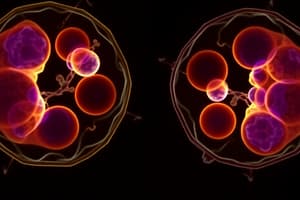Podcast
Questions and Answers
What are the three phases of interphase, and what is the main function of each?
What are the three phases of interphase, and what is the main function of each?
G1 phase is for basic cell growth, S phase is for DNA synthesis, and G2 phase is for preparing for mitosis.
Describe the key events that occur during prophase.
Describe the key events that occur during prophase.
During prophase, chromosomes become visible, the nuclear membrane begins to disappear, and centrioles move to opposite ends of the cell.
What happens during anaphase and what signals the end of this phase?
What happens during anaphase and what signals the end of this phase?
During anaphase, chromosomes are pulled apart toward opposite poles, and it ends when chromosomes stop moving.
How does cytokinesis differ between animal and plant cells?
How does cytokinesis differ between animal and plant cells?
What is cell differentiation, and how does it relate to the development of a human from an egg and sperm?
What is cell differentiation, and how does it relate to the development of a human from an egg and sperm?
Explain the relationship between DNA mutations and cancer development.
Explain the relationship between DNA mutations and cancer development.
Identify and describe the main function of stem cells.
Identify and describe the main function of stem cells.
What is the primary difference between mitosis and meiosis?
What is the primary difference between mitosis and meiosis?
Flashcards
Cell Cycle Phases
Cell Cycle Phases
The cell cycle is divided into phases: Interphase and M phase. Interphase is further divided into G1, S, and G2 phases. M phase is known as mitosis and includes prophase, metaphase, anaphase, and telophase.
Interphase: G1 Phase
Interphase: G1 Phase
The G1 phase is the first phase of interphase where the cell grows and performs its normal functions.
Interphase: S Phase
Interphase: S Phase
The S phase is the second phase of interphase where DNA replication occurs, creating two identical copies of the cell's DNA.
Interphase: G2 Phase
Interphase: G2 Phase
Signup and view all the flashcards
Mitosis: Prophase
Mitosis: Prophase
Signup and view all the flashcards
Mitosis: Metaphase
Mitosis: Metaphase
Signup and view all the flashcards
Mitosis: Anaphase
Mitosis: Anaphase
Signup and view all the flashcards
Mitosis: Telophase
Mitosis: Telophase
Signup and view all the flashcards
Study Notes
Cell Cycle and Mitosis
- The cell cycle is a series of phases, including interphase and the M phase (mitosis)
- Interphase comprises G1, S, and G2 phases.
- G1: Cell growth
- S: DNA synthesis begins; cycle typically completed in this phase
- G2: Cell prepares for mitosis
- Mitosis (M phase) involves four stages: prophase, metaphase, anaphase, and telophase.
- Prophase: Chromosomes condense, become visible; nuclear membrane breaks down; centrioles move to opposite poles; spindle fibers form
- Metaphase: Chromosomes align at the cell's center; spindle fibers attach to centromeres
- Anaphase: Sister chromatids separate and move to opposite poles; spindle fibers shorten
- Telophase: Nuclear membrane reforms around each set of chromosomes; chromosomes decondense; spindle fibers break down; nucleolus reappears
- Cytokinesis is the division of the cytoplasm
- Animal cells: Cell membrane pinches inward, forming two daughter cells
- Plant cells: Cell plate forms between nuclei, eventually developing into a new cell wall
Differentiation and Stem Cells
- Differentiation: Specialized cells develop from less specialized cells
- Example: egg + sperm → chromosomes → mitosis → separation → human
- Stem cells: Unspecialized cells that can differentiate into various cell types
Mitosis and Cancer
- Cancer: A disease where cells escape normal cell division controls.
- Causes of cancer: DNA mutation in genes that regulate cell division
- Tumors: Masses of cancer cells
- Benign: Tumors remain at the original site; typically can be surgically removed
- Malignant: Some cells migrate to other parts of the body (metastasis); tumor cells signal the body to produce new blood vessels (angiogenesis), providing nutrients for fast growth and metastasis capability.
- Metastasis: The spread of cancer cells to other parts of the body.
- Treatment: Surgery, radiation, and chemotherapy are used to treat cancers.
Studying That Suits You
Use AI to generate personalized quizzes and flashcards to suit your learning preferences.


